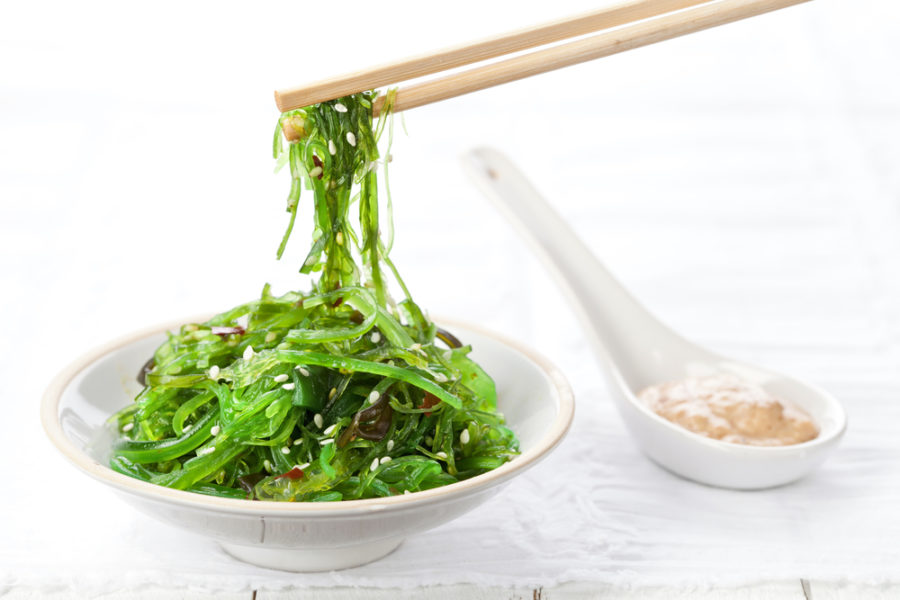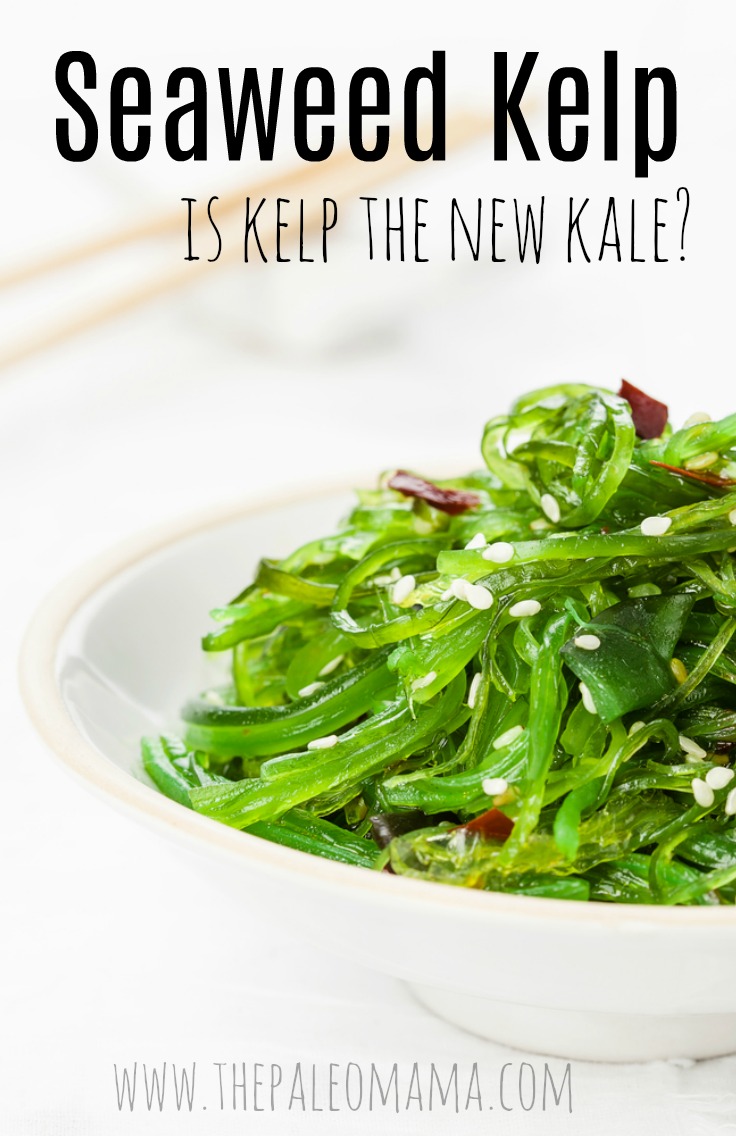
Well, I’m guessing that many of you thought, “Yuck,” when you read today’s blog title. That’s what I thought too, until I tried it, and it’s become sort of standard fare around here now. Especially as an item to send in my daughter’s lunchbox. She loves “Nori,” which is kelp seaweed that comes in thin sheets, and can be found in most Asian grocery stores. Seaweed Kelp is also the thin paper-like dark green wrapping the keeps pieces of sushi neatly contained. Sushi is something else that my family loves—and has been known to indulge in!
But many of you have probably not put seaweed on your food menus yet. According to Food and Wellness trends for 2016, seaweed came in as the number 1 trend last year! The health and wellness website, well+Good has predicted that it will take over kale’s spot in the top trends. So if seaweed kelp is becoming the new kale, I think it’s time we took a closer look at it. We’ll look at three things:
- Exactly what is seaweed kelp?
- How is seaweed being used in food planning?
- How can I use seaweed in my home meals?
1. Exactly What Is Seaweed Kelp?
Seaweed kelp is a marine vegetable, and it has been an important food, fuel, and fertilizer since ancient times. It’s heavy on nutrition, light on empty calories, and it comes with many superfood benefits. Let me list some of those benefits so you can see the huge amount of nutrition that can be gained from humble seaweed.
- Good source of iodine (our body doesn’t produce iodine but we need it in order to make thyroid hormones.)
- It has antioxidant, antifungal, and anti-inflammatory properties
- It is useful for regulating estrogen
- It contains vitamins A, C, and all the B’s
- It contains calcium, magnesium, iron, fiber, amino acids, and good fats
So you can see why many are calling seaweed kelp a superfood, and predicting that kelp is the new kale. But it’s not only important for the nutrition it contains, but also for how is works to improve our health.
- Studies have shown that it may help to improve digestion and reduce fat absorption.
- Other studies suggest that it has anticancer, antiviral, and anticoagulant properties.
Seaweed is fairly easy to farm, and is super-sustainable. It grows quickly, as much as 5-10 inches a day. It doesn’t consume any of the ocean’s natural resources as it grows, doesn’t need any pesticides of fertilizer, and is easily harvested. I wish those qualities were present in all of the vegetables I’m trying to grow!
2. How Is Seaweed Kelp Being Used in Food Planning
There are several types of seaweed (sea vegetables) that are nutritious and useful to our health. Nori is one of them, and most likely you’ve seen that one in your sushi rolls. But other types of seaweed include dulse, which can be sprinkled on food to add nutrients, and wakame, which is used to make Japanese miso soup.
But seaweed is no longer just used in America for sushi. Chefs are incorporating this sea vegetable in many new and tasty dishes. Here are just a few ways you might find seaweed offered in your restaurant menu.
- Seaweed butter—Chef are offering seaweed butter as a great spread for their homemake sourdough biscuits and bread.
- Seaweed beignets—restaurants focusing on unique specialties have added these airy, seaweed and tofu little deep-fried nuggets served with a dab of tasty sauce.
- Kelp-noodle dishes—many other chefs are serving sea palm or kelp noodles in menu dishes from Pad Thai, in soups and salads, and in specialty casserole type dishes.
- Sugar kelp fettucine—one delicious sounding pasta dish served in restaurants uses Maine seaweed is a fettucine dish that includes mushrooms and spring onions.
There are many other seaweed dishes showing up in restaurants across the nation. It is used in breads, added to burgers, infused with dairy products, and even prepared as a substitute for bacon (dulse tastes like bacon).
It is still in the experimental stage for many chefs. Chefs are pairing it with fish or meat dishes, or adding it to vegetarian dishes as added protein. It is showing up in every menu course, even in desserts. It is packed with protein and nutrients, is easy to work with, easily stored, as doesn’t cause food allergies. It’s wonderful flavor kick is one of the main reasons so many chefs have started using it—driving this humble sea plant to the number one trend in food circles.
3. How Can I Use Seaweed Kelp in My Home Meals
If you are like me, it’s always just a bit intimidating to start using a new ingredient in my cooking. But by now, I’ve tried—and liked—so many new foods in the last five years that I’ve taken on the C’mon, you can do it! mantra when I’m trying something else new.
So here are a couple of tips to help you get started using seaweed with your family.
- Go shopping—you can buy seaweed at many Asian markets, and in the ethnic aisles of many supermarkets. Dried versions are easiest to find, including three of the most common types: Nori, Kombu, and Wakame. Start with Nori sheets which you can find in most grocery stores and in with different spices!
- Get cooking—some of the best ways to start cooking with seaweed are: add it to your meat braises, mix it into marinades, blend it with softened butter, make it the star of your salad (try using miso dressing on it), serve it as a crunchy snack, and add it to soups you would normally add a green like spinach or kale to. You can even make homemade sushi with it. I’ve done that several times, and we really love our sushi.
- Get sprinkling —Use this Kelp Granule salt alternative and sprinkle it on all your foods! I love it on my eggs in the morning!
Sample recipes using seaweed kelp
- Stirred into a Smoothie or fresh squeezed juice—Mix about ¼ tsp. in per serving. You can find a delicious Superfood Smoothie recipe here.
- Mix it into a salad dressing—Add a maximum of about ¼ tsp. per serving when making your dressing. Both dulse and kelp are tasty with a simple olive oil and vinegar dressing. You can find a more complex Seaweed Salad Dressing here.
- Blend it into your favorite dip—Add 1-2 tsps to this delicious Cilantro Pesto recipe.
- Mix it with spices as a seasoning—Try mixing a little kelp powder as a salt substitute to cayenne, garlic, parsley, rosemary, thyme, turmeric, or cumin blended seasoning.
- Add it to soups and stews—Kelp can add a spark of flavor to stocks, soups, and stews. Sprinkle in about a tablespoon or so just before you serve. Try this delicious sounding Coconut Soup with Kelp Noodles and Shrimp.
- Roll em’ up —Take your regular nitrate-free lunchmeat and some vegetables and make Paleo Nori Rolls!
- Make some sushi — Spread some avocado on the Nori Sheet, add some smoked salmon, cucumber and spices. Try this Paleo Sushi recipe.
Get Started
This information has given you some ways to sneak seaweed kelp into your diet more often. Go on and give it a try. We did, and I am committed to finding new and unique ways to add this healthy superfood to my family’s menu.
If you don’t want to cook with it you can also use Kelp Granules and sprinkle them on your foods. This is a delicious salt alternative for those who are on a low sodium diet.
“I thought seaweed was hippy, globetrotting stuff but our ancestors ate seaweed. It’s got a load of iodine and it’s the most nutritious vegetable in the world… It’s like dynamite—fiber, nutrients, all the minerals, aids digestion—unbelievable.”
—Jamie Oliver

Sources
Leave a Reply